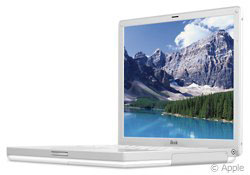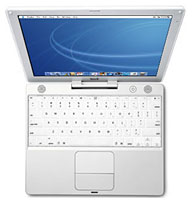Mac Musings
The October 2004 iBook and Power Mac Value Equation
Daniel Knight - 2004.10.20
On Monday, I speculated what we might expect Apple to release this month. Yesterday Apple released faster iBooks and a single-processor Power Mac G5 - neither items that I'd expected.
New iBooks
I wrote, "New iMacs, Power Macs, or PowerBooks are unlikely. iBooks are nearly as fast as PowerBooks, so don't expect a change there." And then Apple proved me wrong.
The biggest surprise is that Apple now has an iBook, the 14" 1.33 GHz model, that's as fast as a PowerBook. Okay, it's only as fast as the entry-level PowerBooks, but that marks a shift in thinking for Apple. Now you can buy a consumer laptop with as much computing power as the "pro" PowerBooks offer.
The second surprise is including AirPort Extreme with the new iBooks without boosting the price. The new models have more speed, wireless networking, and improved value.
14" iBook G4/1.33 GHz
The new 14" iBook G4 runs at 1.33 GHz, replacing 1.0 GHz and 1.2 GHz models. That's 33% faster than the old entry-level book - very impressive - but only a tiny 11% improvement on the top end.
 The 14" Combo drive
iBook sees a huge boost in speed, adds AirPort
Extreme, and sells for the same US$1,299 as the model it replaces.
That's a significant improvement in value.
The 14" Combo drive
iBook sees a huge boost in speed, adds AirPort
Extreme, and sells for the same US$1,299 as the model it replaces.
That's a significant improvement in value.
The 14" SuperDrive iBook is only a bit faster, so the value improvement hasn't improved nearly as much - but it's still an improvement, and it does add a SuperDrive at the same price as the previous 1.2 GHz Combo model.
12" iBook G4/1.2 GHz
At the entry level, the 12" iBook gets 20% faster, adds AirPort Extreme, and drops by US$100. For the first time since Apple discontinued the iBook G3/800 MHz, Apple has a US$999 iBook, and this time it has a Combo drive (vs. a plain old CD-ROM in the iBook 800).
 The value improvement easily
equals that of the Combo drive 14"
iBook G4/1.33 GHz. More than that, Apple is breaking an important
psychological price barrier, so I expect the 12" iBook G4/1.2 GHz to be
a runaway success.
The value improvement easily
equals that of the Combo drive 14"
iBook G4/1.33 GHz. More than that, Apple is breaking an important
psychological price barrier, so I expect the 12" iBook G4/1.2 GHz to be
a runaway success.
Where the 12" 'Book really stands out, though, is in comparison to the aluminum 12" PowerBook G4/1.33 GHz. The small PowerBook is a bit lighter, a bit more compact, and a bit faster (just about 10%), but at a $600 difference in price. I think it's going to be hard sailing for the 12" PowerBook unless Apple slashes the price by about US$200.
Power Mac G5/1.8 Single
More words to haunt me: "October seems to be the month for primarily consumer hardware, not the high-end pro gear. In light of that, maybe Apple will borrow a page from it's history and introduce a low-end modular Mac. That's far less likely than a flat-panel or speed-bumped eMac, and there's no indication Apple will ever attempt to offer the kind of low-cost modular machine that attracts so many Windows users."
No, the new Power Mac G5/1.8 GHz model isn't quite what I had in mind there, but it does slash US$500 from the entry price on a modular Mac. Considering all the technology in the Power Mac G5, this is probably as low as Apple can go without creating an entirely new design for the low end.
Other than the single CPU, the only difference between the G5/1.8 GHz Single and the G5/1.8 GHz Dual is a slower memory bus. The new Power Mac runs memory at one-third CPU speed (600 MHz) vs. half CPU speed (900 MHz) in the dual processor machine.
For Mac users who wanted a Power Mac G5 but couldn't justify the US$2,000 price tag, the new single CPU model provides most of the power (in typical use, probably about 60% as much as the dual processor model) and all of the features at a 25% drop in price. For those who need to use PCI cards, want more than one internal hard drive, or want to use one or more external displays, the Power Mac G5/1.8 GHz Single looks like a good value.
But for those who would be satisfied with a 17" or 20" display, the iMac G5 should prove very tempting. Both the 17" SuperDrive iMac G5 and the Power Mac G5/1.8 GHz Single have the same retail price.
- Both have a single 1.8 GHz G5 CPU and a 600 MHz memory bus.
- The iMac G5 includes a display; you have to add a display to the Power Mac, but it can support more than one monitor.
- The Power Mac G5 has FireWire 800; the iMac G5 doesn't.
- The Power Mac G5 has three PCI expansion slots, four video card options, and room for multiple internal drives; the iMac G5 doesn't.
- The Power Mac G5 burns DVDs at 8x; the iMac G5 burns at 4x.
The two machines are obviously geared toward different markets. The Power Mac is for the power user who needs expansion options. The iMac is for the average user who never needs to add an expansion card and sees no reason to want a second hard drive in the computer.
Ignoring expansion, the iMac G5 is definitely the better value - but for users who can't ignore expansion, G5 power just became more affordable.